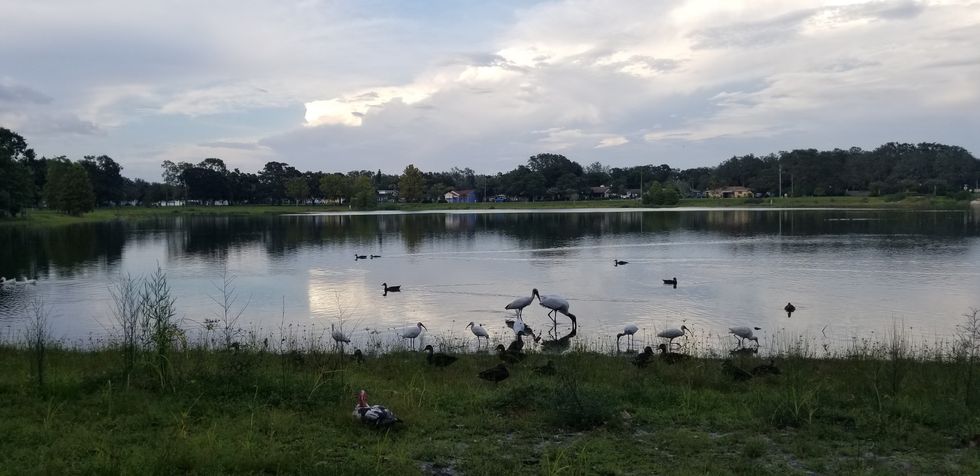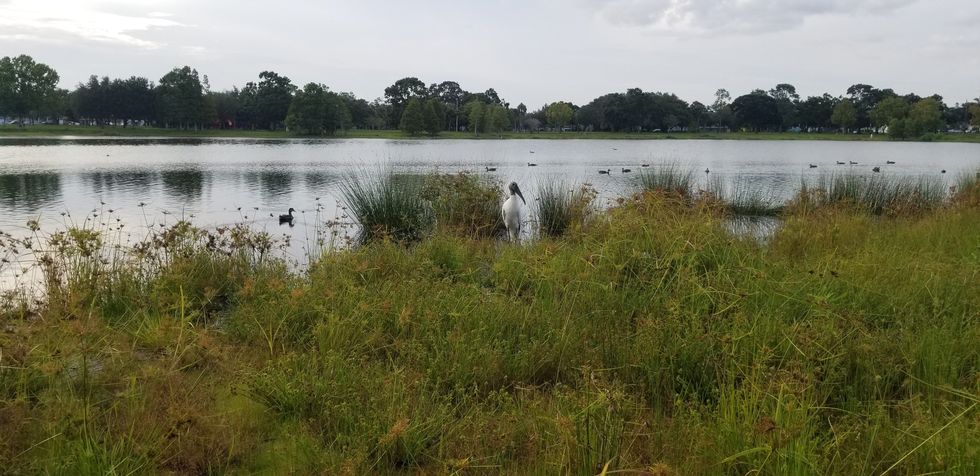There is one species of native storks found in the U.S., and that is the wood stork. Wood storks are unique birds. With broad white wings, black flight feathers, gray, scaly bald heads, and long thick beaks perfect for foraging, they remind me of prehistoric birds.
These birds require tropical and subtropical wetland habitats to survive and thrive. So, they are mostly found in Florida, Georgia, and South Carolina where there are optimal wetlands for them to forage. I first saw a wood stork in western Florida at a little, shaded lake in a park. A few of them stood on the shore. They looked different than the usual herons, egrets, and ibises I would see. I looked them up when I got home and found that they were called wood storks and they were once on the endangered species list in America.
The wood stork was listed as federally endangered in 1984 and downlisted to threatened in 2014. The numbers of storks in southern states were once over 150,000; by the early 1990s that number was not much over 10,000. The loss was mainly because of Florida's water management that disrupted the natural water flow that storks depended on for catching food. Storks like to forage in the dry season of wetlands when pools become small and isolated, concentrating fish, making feeding easy. With water management, those normal dry phases in the wetlands are disrupted making it harder for storks and other birds to find food.
Near where I live, nearly every morning, we drive past a small pond that is, for some reason, a popular bird spot. It is shallow with long native grasses planted around the edges. I see at least five storks there almost every morning. Knowing that these birds are threatened and were once endangered in the United States makes it that much more special to see them. I have wanted to go to that pond sometime and get a closer look at the storks.
The other day me, my husband, and two of my sisters went to a park we went to before in Clearwater where we know there are many birds. I think people must feed the birds there and there is probably a good amount of fish and other food sources in the lake. We always see dozens, maybe hundreds of ducks as well as ibises, and other birds. Last time we went I saw a roseate spoonbill; they are always a special treat to see with their bright pink, flamingo-like colors, and spoon-shaped bill.
This time when we went to the park we first saw dozens of ducks; then in the wetland grasses on the edge of the lake, I saw a stork, standing still. I was able to step closer and get a good picture of him. We continued around the lake watching ducks who were constantly quacking, ibises grazing in the grass along the edge of the lake, turtles swimming in the lake, and finally, two more storks flew in. They glided down. They had five-foot wingspans. As they approached the water, they dropped their legs in front of them and made a clumsy landing in the water.

I came closer, finally able to watch them up close and get pictures of them. The two storks slowly waded in the water and dipped their massive beaks in. The held their beaks slightly open slowly moving them back and forth in the water. I assumed they were searching for food. Then I noticed one kicking its foot in the water. I had never seen a bird do that before. He was scattering his food. The other stork started to do it as well. Storks use touch to find their prey, fish in the water. Rather than use sight like most wading birds, they feel around the water with their bills. When a fish swims into their bill and touches it their bills snap shut, and they lift their heads from the water to swallow it.

I was happy not only to see storks but see them foraging in their unique way. Storks are an important species to the native Florida landscape. The health of this species is a good indicator for the health of the whole ecosystem. Their numbers are still low compared to what they once were, and it's important to protect them and help their numbers increase. Hopefully, the lakes in my area will remain healthy as well and be able to support storks well into the future.

















